In the competitive oral care market, product reliability is crucial for brand reputation. One of the most frequent technical complaints from end-users is Electric Toothbrush Motor Failure. A faulty motor can lead to poor performance, increased warranty claims, and dissatisfied customers. For any electric toothbrush manufacturer, understanding toothbrush motor issues and preventing them in the production stage is essential for long-term success.
This article will explore Motor Failure Common Causes and practical solutions that brand owners should look for when evaluating manufacturing partners.
The motor is the heart of an electric toothbrush. Whether it’s a sonic vibration motor or a rotary type, it must operate at consistent speeds and torque to ensure effective cleaning. When motor performance drops—slowing down, producing noise, or failing entirely—the toothbrush becomes ineffective.
Key warning signs include:
Reduced vibration or oscillation speed
Irregular noise during operation
Overheating in the handle
Complete stoppage (a burnt-out electric brush)
Through industry feedback and engineering analysis, the most common causes of Electric Toothbrush Motor Failure include:
Poor Component Quality – Low-grade coils, magnets, or bearings can wear out quickly.
Water Ingress – Inadequate sealing leads to moisture entering the motor chamber, causing corrosion.
Overheating – Continuous operation beyond design limits can damage the motor windings.
Electrical Overload – Poor battery control systems can lead to voltage spikes.
Improper Assembly – Misalignment during production can increase friction and reduce lifespan.
For brands, the best prevention starts with partnering with an electric toothbrush manufacturer that uses high-grade materials, rigorous waterproofing tests, and precision assembly methods.
To reduce toothbrush motor issues, both design and manufacturing quality need attention:
Enhanced Waterproofing: Use IPX7 or higher waterproof ratings to prevent water ingress.
Motor Quality Testing: Implement load tests, life cycle simulations, and vibration checks before shipment.
Overload Protection Circuits: Integrate smart chips to regulate voltage and prevent overheating.
High-Quality Materials: Use corrosion-resistant metal parts and heat-resistant coil insulation.
Precision Assembly: Ensure automated alignment for consistent motor positioning.
A reliable electric toothbrush manufacturer will already have these quality control measures in place.
For oral care brands, choosing a manufacturing partner is as important as product design. Look for suppliers who:
Have a track record in producing electric toothbrushes with low defect rates
Offer in-house motor development and testing capabilities
Provide design feedback to optimize motor performance
Can customize motor specifications to match brand needs
The right partnership ensures fewer warranty claims, longer product life, and stronger brand trust.
Electric Toothbrush Motor Failure is a preventable issue—if addressed early in the design and production stages. By understanding Motor Failure Common Causes and implementing targeted solutions, brands can deliver reliable products that win customer loyalty.
When searching for an electric toothbrush manufacturer, prioritize those who focus on preventing toothbrush motor issues from the start. A strong manufacturing partnership means fewer “burnt-out electric brushes” in the market and more satisfied customers.

How to choose a reliable electric toothbrush factory?
.jpg)
Can a Florida electric toothbrush soothe Florida sensitive gums?

How Does a Polishing Brush Head Enable Enamel-Safe Whitening?

Contact Charging vs. Induction: Best Electric Toothbrush Charging Method Options

Do Multi-Color Toothbrushes in a Bundle Savings Deal Prevent Sibling Fights?

How to Start a Teeth Whitening Business

What types of batteries are currently available for electric toothbrushes?

Guide for Oral Care Brands Seeking San Diego Water Flosser & Toothbrush Combo Custom Kits Suppliers

7 Reasons to Start Your Electric Toothbrush Business in 2023
.jpg)
Electric Toothbrush Troubleshooting Flowchart: A Practical OEM Guide for Brands

How Much Does It Cost to Manufacture a Toothbrush?

How much does it cost to manufacture a toothbrush?

Can a Dual Care Brush Be Both a Teeth Whitening Brush and Gum Massager?

Budget electric brush OEM Manufacturers in Los Angeles

Cutting-edge tech makes us apart from other electric toothbrush manufacturers

How to Install Electric Toothbrush Heads Correctly: Proper electric toothbrush head installation Guide for Brands and Users

electric toothbrush heads Charcoal Infuse-Round

electric toothbrush heads Ultra Soft

Customization Teeth Whitening Gel
.jpg)
Florida Electric Toothbrush – Powsmart PTR-C8

Electric toothbrush heads Charcoal Infused-Diamond

electric toothbrush heads Deep Clean

Private Label Whitening Gel

electric toothbrush heads Regular Clean
whstapp
whstapp
National Toll-Free Service Hotline
+86 755 86238638